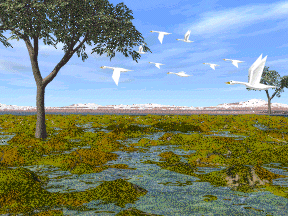
The fenlands of Nîn-in-Eilph. In the far distance, the
Misty Mountains can be seen.
Glanduin, the river that had once marked the southern border of Eregion, ran down westward from the Misty Mountains, and as it approached its junction with Mitheithel or Hoarwell, it ran over a stony fall and its waters began to slow. Dividing into numerous smaller branches, this lower part of the stream was known as the Swanfleet river. Its spreading waters formed wide marshes that stretched for some fifty miles, and were dotted with islets and pools. These waterlands were frequented by numerous waterbirds, especially swans, and so they were named in Elvish as Nîn-in-Eilph, the Waterlands of the Swans.
In earlier ages, the wide lands westward of the Misty Mountains had been covered by dense forests, with the Great Fens of Nîn-in-Eilph forming the only treeless land within a canopy of unbroken woodland that otherwise stretched for hundreds of miles. During the Second Age, the trees of this vast forest were felled by the Númenóreans, leaving the lands surrounding Nîn-in-Eilph as an empty plain, and so they remained into the Third Age.
When the Dúnedain founded their Two Kingdoms in Middle-earth in the late Second Age, they constructed a long North-South Road to connect their realms. That road passed Nîn-in-Eilph on the western edge of the marshes, below the confluence of the rivers Glanduin and Mitheithel. The land here was still so boggy that the road-builders had to construct a raised causeway as their road ran through this watery landscape. After Glanduin and Mitheithel joined, they formed the river Gwathló or Greyflood, and on this wider river stood the township of Tharbad, where the raised road crossed the river by a great bridge.
The road gradually fell into disuse, and eventually the causeway through the marshes was no longer maintained. In III 2912, the thaw from the Fell Winter caused immense floods to sweep through this area, and the Bridge of Tharbad was swept away, so that the western route around Nîn-in-Eilph became almost impassable. There was, however, a track leading around the eastern side of the fens, leading to a ford over the stream of Glanduin before it ran over its waterfall and spread into the marshlands to the west. It was this way that the Travellers passed on their journey back to the Shire after the War of the Ring.1
Notes
1 |
Given that there was a relatively simple crossing of Glanduin eastward of Nîn-in-Eilph, it is perhaps slightly strange that, on his northward journey to Rivendell, Boromir followed the much harder route along the old North-South Road. Thus he was forced to make a crossing at Tharbad that proved so difficult that he lost his horse. Perhaps he simply did not know about the ford, or perhaps (given that the ford lay some fifty miles eastward of the broken Bridge of Tharbad) he considered it to be too far out of his way.
|
Indexes:
About this entry:
- Updated 13 September 2023
- This entry is complete
For acknowledgements and references, see the Disclaimer & Bibliography page.
Original content © copyright Mark Fisher 1999, 2001, 2022-2023. All rights reserved. For conditions of reuse, see the Site FAQ.

